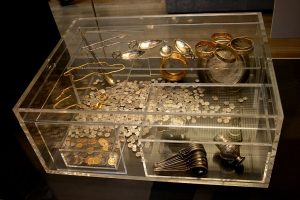 I don’t know about you, but when I go looking for something I’ve lost, usually because I put it in a place that I would know where to find it, I always seem to find several other “treasures” I had forgotten I had. I can’t tell you how many times that has happened to me, even if I had been intently looking for the “treasure” that I finally find when I’m no longer looking for it. That happens to a lot of people, but it’s not likely that the “treasures” we find, are worth anywhere near the value of the treasure that was found by Eric Lawes, when on November 16, 1992, he set off for a field in Hoxne village, Suffolk. He wasn’t even heading out on a treasure hunt. He was searching for his lost hammer!!
I don’t know about you, but when I go looking for something I’ve lost, usually because I put it in a place that I would know where to find it, I always seem to find several other “treasures” I had forgotten I had. I can’t tell you how many times that has happened to me, even if I had been intently looking for the “treasure” that I finally find when I’m no longer looking for it. That happens to a lot of people, but it’s not likely that the “treasures” we find, are worth anywhere near the value of the treasure that was found by Eric Lawes, when on November 16, 1992, he set off for a field in Hoxne village, Suffolk. He wasn’t even heading out on a treasure hunt. He was searching for his lost hammer!!
At his recent retirement, Lawes had received a metal detector as a gift. So Lawes set off to find a hammer he had lost on the farmland. The detector picked up a strong signal in the earth, leading Lawes to start digging. Well…this was not his hammer. After bringing up only a few shovelfuls of silver spoons and gold coins, Lawes quickly retreated and called the police and the local archaeological society. The very next day, as quietly as possible, so as not to create a stir, the archaeologists excavated a chunk of earth with the treasure still contained within. They wanted to remove the objects under strict laboratory conditions, which would help determine the age and storage method of the cache. By the time everything had been removed from the dirt, the archaeologists had nearly 60 pounds of gold and silver objects, including 15,234 Roman coins, dozens of silver spoons, and 200 gold objects. The treasure, which later became labeled as the Hoxne Hoard, was an amazing discovery. Archaeologist Judith Plouviez was extremely excited about the discovery, saying that it was “an incredibly exciting and amazing find.” What’s more, another archaeologist, Rachel Wilkinson, told Smithsonian Magazine that this discovery was “the largest and latest ever found in Britain.”
Normal radiocarbon dating as a means of identifying the age of ancient relics didn’t work in this case. They just couldn’t locate any suitable material for radiocarbon dating from the haul. In the end, they determined the age  by examining writing on the coins, as well as the ruler carved into them. It was estimated that the treasure was probably buried in either 408 or 409 AD. How it had remained hidden all those years is beyond me…especially on a farm, where the field might have been plowed at any time. All in all, the discovery was a real treasure for archaeologists. Lawes didn’t lose out on the deal either. According to Smithsonian Magazine, in recognition of his discovery and willingness to contact authorities, the British government rewarded him with over £1.7 million (2,249,100 in US Dollars), an amount which he shared with the farmer whose land was dug out in order to get the treasure. Oh, and by the way, Lawes also found his lost hammer…which now also resides in the British Museum too.
by examining writing on the coins, as well as the ruler carved into them. It was estimated that the treasure was probably buried in either 408 or 409 AD. How it had remained hidden all those years is beyond me…especially on a farm, where the field might have been plowed at any time. All in all, the discovery was a real treasure for archaeologists. Lawes didn’t lose out on the deal either. According to Smithsonian Magazine, in recognition of his discovery and willingness to contact authorities, the British government rewarded him with over £1.7 million (2,249,100 in US Dollars), an amount which he shared with the farmer whose land was dug out in order to get the treasure. Oh, and by the way, Lawes also found his lost hammer…which now also resides in the British Museum too.


One Response to Searching For A Lost Hammer